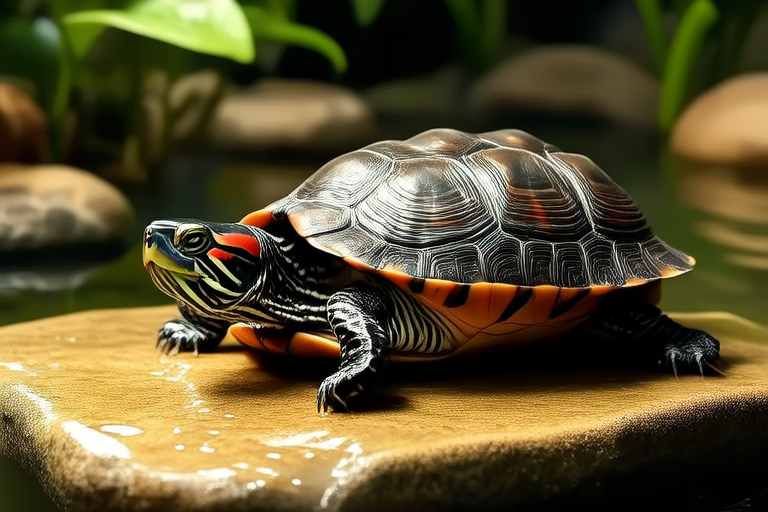The Ultimate Checklist for Red-eared Slider Owners
Welcome to the world of red-eared slider turtle ownership! These charismatic reptiles are popular pets due to their relatively low maintenance and charming demeanor. However, owning a red-eared slider comes with significant responsibilities. This comprehensive guide will help you ensure your turtle’s well-being by covering habitat setup, water quality maintenance, diet and nutrition, health care tips, behavioral insights, and common pitfalls to avoid.
Habitat Setup
Creating a suitable habitat is crucial for your red-eared slider’s health and happiness. A spacious tank or pond with ample swimming space, basking area, and hiding spots is essential. Here’s how to set it up:
- Tank Size: Provide at least 10 gallons of water per inch of shell length for juvenile turtles. Adult red-eared sliders require a minimum of 40 gallons of water.
- Filtration: Invest in a high-quality filtration system to maintain clean water. Regular cleaning is necessary to remove waste and debris.
- Basking Area: Equip your turtle with a dry, easily accessible platform where it can bask under a UVB light to synthesize vitamin D3.
- Heating: Maintain water temperature between 75°F and 80°F (24°C to 27°C) and air temperature around 85°F to 90°F (29°C to 32°C).
- Lighting: Install full-spectrum UVB lighting to promote calcium absorption and prevent metabolic bone disease.
Water Quality Maintenance
Water quality directly impacts your turtle’s health. Follow these guidelines to keep the water pristine:
- Regular Water Changes: Change 25% of the water weekly, more frequently if necessary, to prevent harmful bacteria from thriving.
- Monitor pH Levels: Maintain pH levels between 6.5 and 8.0 to ensure optimal health.
- Test for Ammonia and Nitrites: Use test kits to monitor ammonia and nitrite levels, which should be kept at zero to prevent toxicity.
- Avoid Chlorine: Dechlorinate tap water before adding it to the tank to protect your turtle’s sensitive respiratory system.
Diet and Nutrition
A balanced diet is key to your turtle’s longevity and vitality. Feed your red-eared slider a variety of foods:
- Variety is Key: Offer a mix of commercial turtle pellets, fresh vegetables like kale, collard greens, and squash, and occasional protein sources such as earthworms, crickets, and lean meats.
- Supplements: Supplement their diet with calcium and vitamin D3 to support strong bones and healthy shell growth.
- Feeding Schedule: Feed juveniles daily and adults every other day to prevent obesity and related health issues.
- Proper Handling: Wash hands thoroughly after handling food or feeding your turtle to prevent the spread of bacteria.
Health Care Tips
Regular check-ups and proactive care can help your turtle live a long, healthy life. Here are some tips:
- Regular Vet Visits: Schedule annual check-ups with a veterinarian specializing in reptiles to catch potential health issues early.
- Signs of Illness: Watch for lethargy, loss of appetite, swollen eyes, or irregularities in skin color or shell texture.
- Shell Health: Keep the shell clean and inspect it regularly for signs of injury or infection.
- Behavioral Cues: Monitor changes in behavior that may indicate stress or discomfort.
Behavioral Insights
Understanding your turtle’s behavior can enhance your relationship and provide valuable insights into its needs:
- Basking Behavior: Encourage natural basking habits by providing a warm, inviting platform.
- Social Interaction: While not social creatures, red-eared sliders can benefit from gentle handling and interaction.
- Environmental Enrichment: Introduce novelty items like floating logs or underwater caves to stimulate exploration.
- Stress Reduction: Minimize handling during shedding periods to allow your turtle to focus on regrowth.
Common Pitfalls to Avoid
Avoid these common mistakes to ensure your red-eared slider thrives:
- Inadequate Space: Overcrowding can lead to stress and disease. Ensure each turtle has enough room to swim freely.
- Improper Lighting: Insufficient UVB exposure can cause metabolic bone disease. Always use appropriate lighting.
- Overfeeding: Excessive feeding can lead to obesity and related health problems. Stick to a balanced diet.
- Lack of Cleanliness: Poor hygiene can result in bacterial infections. Maintain a clean environment to prevent illness.
Owning a red-eared slider is a rewarding experience when approached with knowledge and care. By following this checklist, you can provide a safe, enriching environment for your pet, ensuring it lives a long and healthy life. Remember, responsible ownership involves continuous learning and adaptation to your turtle’s needs.
